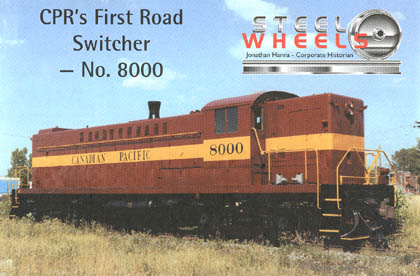
Canadian Pacific Railway Employee
Communications
Room 500 401-9th Ave S.W. Calgary AB T2P 4Z4
|
VOLUME
THIRTY-TWO
|
NUMBER
ONE 2002
|
CPR's First Road Switcher - No.
8000

By
Jonathan Hanna - Corporate Historian
By 1947, CPR had 10 years of
experience using diesel-electric locomotives in yard switcher service.
Diesel-electric switchers were in yards in four of Canada's major railway
centres - Montreal, Toronto, Winnipeg, and Calgary. And CPR's research department was
convinced diesel-electric motive power efficiencies would work in road
service applications, too.
What better place to test this out than on the wholly-owned Esquimalt
& Nanaimo Railway (E&N) on Vancouver Island. With its 140 miles of main
line and 65 miles of branch lines, the E&N formed a perfect microcosm where
"dieselization-by-territory" could be tested.
The E&N program replaced the island's 20 steam locomotives - 18
D-class 4-6-0 road locomotives and two U3-class
0-6-0 switchers - with 13 all-purpose road switcher
diesel-electric locomotives. These were numbered CP 8000 to CP 8012.
The first five - Nos. 8000 to 8004 - were equipped with steam generators for use in
passenger service.
With the exception of its first experimental diesel-electric locomotive -
No. 7000 - built at National Steel Car's plant in Hamilton, Ont., CPR to that point
had bought American Locomotive Company (ALCO) switchers exclusively.
But eager to get going on the dieselization program, CPR president W.M. Neal accepted
an offer from the Canadian Locomotive Company (CLC) in Kingston, Ont. With Alco
production backed up and its own Kingston plant not quite ready to rollout
full-size locomotives, CLC offered to produce 24
American-built diesel-electric locomotives - 13 road switchers
and 11 yard switchers - at the Baldwin Locomotive Works plant in Eddystone, Pa.
Vancouver Island's 13 road switchers were the meat of tis order.
CPR's first road switcher, a Baldwin DRS4-4-1000, 1,000 h.p.
diesel-electric locomotive - No. 8000 - rolled out of the Eddystone
plant on 6 Dec 1948. Equipped with a steam generator, it was used in
freight, yard, and passenger service, too.
In 1955, Rail Diesel Cars (RDCs) took over passenger duties on the Island. CP 8000
was stripped of its steam generator a couple of years after the RDC takeover.
Horsepower/tonnage ratios and diesel-electric motive power utilization
were even better than the research department had imagined. So a few of the
8000-series Baldwin road switchers were sent to the mainland in return
for a single yard switcher.
The initial experiment of dieselization by territory was a success, leading to a
conversion of the entire locomotive fleet by 1960.
CPR retired No. 8000 from active service on 5 Jun 1975. But the company
retained the locomotive for display purposes and repainted it in its original 1948
livery at Montreal's Angus Shops in 1983. The non-operatingdisplay
locomotive is currently assigned to CPR's department of communications and public
affairs.
| |
Vital
Statistics
|
Numbers
|
8000-8012
|
Class
|
DRS-10a
|
Builder
|
Baldwin/CLC
|
Outshopped
|
6 Dec 1948
|
Builder's Model
|
DRS4-4-1000
|
Horsepower
|
1,000
|
Cylinders
|
6
|
Axles
|
4
|
Maximum speed
|
60 mph (96.5 kph)
|
Length
|
58 ft. (17.7 m)
|
Weight
|
237,000 lbs. (107,503 kg)
|
Purchase price
|
$134,241.00
|
©
2005 William C. Slim
http://www.okthepk.ca
|